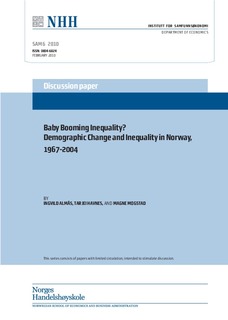| dc.contributor.author | Almås, Ingvild | |
| dc.contributor.author | Havnes, Tarjei | |
| dc.contributor.author | Mogstad, Magne | |
| dc.date.accessioned | 2010-03-22T14:51:22Z | |
| dc.date.available | 2010-03-22T14:51:22Z | |
| dc.date.issued | 2010-02 | |
| dc.identifier.issn | 0804-6824 | |
| dc.identifier.uri | http://hdl.handle.net/11250/163204 | |
| dc.description.abstract | We demonstrate how age-adjusted inequality measures can be used to evaluate
whether changes in inequality over time are because of changes in the age structure. In particular, we explore the hypothesis that the substantial rise in earnings
inequality since the early 1980s is driven by the large baby boom cohorts approaching the peak of the age-earnings profile. Using administrative data on earnings
for every Norwegian male over the period 1967-2004, we find that the impact of
age adjustments on the trend in inequality is highly sensitive to the method used:
while the most widely used age-adjusted inequality measure indicates that the rise
in inequality in the 1980s and 1990s is indeed driven partly by the baby boom, a
new and improved age-adjusted measure indicates the opposite, namely that the
rise in inequality was even larger than what the inequality measures unadjusted for
age reveal. | en |
| dc.language.iso | eng | en |
| dc.publisher | Norwegian School of Economics and Business Administration. Department of Economics | en |
| dc.relation.ispartofseries | Discussion paper | en |
| dc.relation.ispartofseries | 2010:6 | en |
| dc.subject | inequality trend | en |
| dc.subject | age structure | en |
| dc.subject | age-earnings profile | en |
| dc.subject | Gini coefficient | en |
| dc.title | Baby booming inequality?: demographic change and inequality in Norway, 1967-2004 | en |
| dc.type | Working paper | en |
| dc.subject.nsi | VDP::Samfunnsvitenskap: 200::Økonomi: 210::Samfunnsøkonomi: 212 | en |
| dc.subject.nsi | VDP::Samfunnsvitenskap: 200::Demografi: 300 | en |
